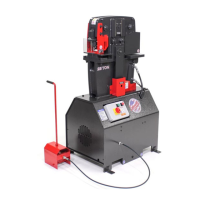7
Your Ironworker may include a notcher as an optional feature.
When maintained within tolerance, the notcher will provide a dis-
tortion and burr free notch cut to mild steel bar, plate or angle
iron. Notcher tooling is equipped with one, three-sided top notcher
blade and three, four-sided bottom blades. The top blade is mount-
ed to the moving “center” of the Ironworker, while the bottom
three blades are secured into a base housing. Notcher blades are
wearing parts and need to be maintained or replaced over time.
Observe the following procedure when maintaining the Ironworker
notcher station.
Turn off power to machine by depressing the red stop / off
button and lockout upstream power at the main electrical
panel.
Remove and replace moving blade:
1. Remove or swing the notcher guard assembly up and away from
the notcher table.
2. Remove the two 1/2” socket head cap screws that secure the ex-
isting top notcher blade to the moving center.
3. Clean the keyway in the moving center of any dirt or debris.
4. Install the top notcher blade with the keyway up and the “foot” of
the blade facing the center of the machine. Secure the top blade
using two 1/2” socket head cap screws. Tighten bolts.
Remove and replace stationary blades:
1 Loosen the set screws (if provided) located at the sides of the
notcher table.
2. The notcher table includes three blades secured within the table
housing. Remove the four 1/2” bolts and washers that secure
notcher table to the base table.
3. Carefully remove the notcher table assembly to a secure work-
bench. The top table that holds the blade set is secured by eight
3/8” socket head cap screws - four from the top working surface,
four from the underside of the notcher assembly. Remove all eight
cap screws to seperate the blade housing from the notcher assem-
bly. Remove the top table from the assembly.
4. Remove the six 3/8” socket head cap screws that secure the
blades into the base table housing.
5. Clean the blade pockets of any dirt or debris.
6. The bottom shear blades have multiple cutting surfaces. Either ro-
tate/ ip the existing blade set to the new cutting surfaces or install
new cutting blades into the blade pockets. Re-install the six 1/2”
socket head cap screws and tighten. The blades should be planar
to eachother at the top surface of the working table.
7. Re-install the eight cap screws that secure the top table housing to
the bottom table housing.
8. Re-install the notcher table with the open “U” facing the center of
the machine. The guide foot of the top notcher blade should be
centered within the base table blades.
9. Loosely secure the notcher table from the underside of the base
with four 1/2” bolts and washers (provided).
10. Check for top and bottom blade alignment by powering up the ma-
chine and slowly inching down the top blade to meet the bottom
blades with the foot pedal. Power the machine off.
11. Using a feeler gauge, adjust the clearance between the perimeter
of the top and bottom blades to allow for .010 clearance on all
three sides.
12. In the event that the top and bottom blades are not aligned, simply
loosen the bolts under the table allowing the table to be moved
to center the top blade within the bottom blades. When aligned,
tighten the table bolts to secure the table.
13. Adjust the set screws (if provided) at the sides of the notcher table
to engage the base notcher table to the base table. Lock the four
3/8” nuts in place to secure the set screws in place. These added
xtures are to provide additional support to the base table during
the notching operation.
14. Swing the notcher guard back in place.
Optional Tooling - Notcher 25/40/55/100 Ton Ironworkers

